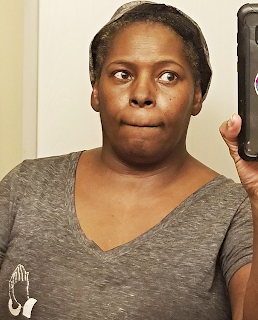African threading is probably the most ingenious hair care technique known. And I am mad that I hadn't heard about it before a couple of weeks ago. I don't usually shout about it but some cultures just never get the credit they deserve.
Why is this not a bigger deal? I don't know. But let's talk about the genius of hair threading. First, some background. I tried to find some older resources but apparently, the threading trend wasn't hot online before 2010 (if my search results can be trusted).
This is what I did find and like, so I am sharing:
This video tutorial is the best one I have seen for learning how to do threading. (And, for some reason, I now think I
might have seen this at some point in the past.)
Currently, there are a lot of videos and articles about threading - some that have been out long enough that I should have noticed before now. I have learned a lot about how to do it but the information sometimes conflicts on what threading material to use (yarn, rubberized thread, metal thread, etc.) or techniques for the ends (tuck and wrap or leave loose, etc.). I like the idea of tucking the ends and was wrapping but it was tricky for me to do with yarn. I could do it with the rubber thread but... well, more on that in a moment.
I used that video tutorial (above) and some of the one in that linked history & tutorial for general guides. However, I did end up trying different threading materials. The first was rubberized thread and did not work well with my very shea-moisturized hair! Here is my process for the 1st and 2nd attempts.
The Supplies I Used
 |
Trying this for the first time &
got it cheaper at Sally's |
 |
And for my scalp, my favorite JBCO
(until I find something better-priced!) |
 |
"Bead String Rubber
Stretchy String Elastic String" |
This is what my hair looked like (unstretched) before I did my first (successful) yarn-threading. It has been washed, deep-conditioned, sealed and moisturized.
This is what my first (and failed) attempt with the rubberized thread looked like:
 |
No Bueno! Unh uh!
(but the ends are tucked) |
I could not get my threading started closer to the root. Again, I think it's because my fingers were too slick with shea.
I removed the rubber thread the very next day, re-washed and conditioned my hair, and started over. This time I went with acrylic yarn. This is cheaper and much MUCH easier for me to use as an inexperienced threader.
This also took less time because I wasn't struggling (unsuccessfully) to keep the threading near the root.
 |
| I did trim the yarn afterward |
 |
| "Kizzy! Kizzy!!" |
I think I did an okay job, I will need to learn to keep the gaps smaller and to get closer to the ends of the hair. The toughest thing will be learning to end up with something stylish enough to wear uncovered. In the meantime, I am wearing scarves. I usually wear these
neck-gaiter-type scarves just because they are a cute (and lazy) way to keep my head warm in the winter.
I can't wait to get through the next several days (5 or 7 is what I am shooting for) so that I can re-thread and see if I do a better job. I am pleased though. The one thing I worry about is that I used too much shea butter. It was literally oozing from between the threads when I finished wrapping my hair. I think it will dry down some though from being threaded and being tucked into a scarf. Plus, it is super arid here in the winter so...
By the way, the threading is not uncomfortable to sleep on. I sleep with the scarf on so that I can secure the threading in a suitable arrangement for laying on.
I will do a Part 2 when I take down and re-thread my hair in - well, however many days I can last!
Peace
--Free
FYI: I linked to the gaiter scarves I use just because I love them so much. I don't get any compensation or affiliate credit. I bought them last year when they were about 10 bucks and, after many washing and almost daily wear, they are like new. I want to get more but I see the price has gone up. The price depends on the color/pattern you choose; I got the Dark Grey set of 6.




















